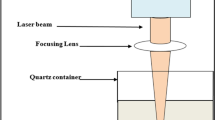Abstract
The rise of antibiotic-resistant bacteria is a rapidly growing global health concern. According to the Center for Disease Control, approximately 2 million illnesses and 23,000 deaths per year occur in the USA due to antibiotic resistance. In recent years, there has been a surge in the use of metal nanoparticles as coatings for orthopedic implants, wound dressings, and food packaging, due to their antimicrobial properties. In this report, we demonstrate that the antibacterial efficacy of silver nanoparticles (AgNPs) is enhanced with exposure to light from the visible spectrum. We find that the increased toxicity is due to augmented silver ion release and bacterial uptake. Interestingly, silver ion toxicity does not appear to depend on the formation of reactive oxygen species. Our findings provide a novel paradigm for using light to regulate the toxicity of AgNPs which may have a significant impact in the development of new antimicrobial therapeutics.



Similar content being viewed by others
References
J.W. Alexander, History of the medical use of silver. Surg. Infect. (Larchmt) 10, 289–292 (2009)
J.A. Lemire, J.J. Harrison, R.J. Turner, Antimicrobial activity of metals: mechanisms, molecular targets and applications. Nat. Rev. Microbiol. 11, 371–384 (2013)
J.-S. Hur, Y. Koh, Bactericidal activity and water purification of immobilized TiO2 photocatalyst in bean sprout cultivation. Biotechnol. Lett. 24, 23–25 (2002)
A.-G. Rincon, C. Pulgarin, Effect of pH, inorganic ions, organic matter and H2O2 on E. coli K12 photocatalytic inactivation by TiO2: implications in solar water disinfection. Appl. Catal. B 51, 283–302 (2004)
J.C. Yu, W. Ho, J. Lin, H. Yip, P.K. Wong, Photocatalytic activity, antibacterial effect, and photoinduced hydrophilicity of TiO2 films coated on a stainless steel substrate. Environ. Sci. Technol. 37, 2296–2301 (2003)
K. Gupta, R.P. Singh, A. Pandey, A. Pandey, Photocatalytic antibacterial performance of TiO2 and Ag-doped TiO2 against S. aureus. P. aeruginosa and E. coli. Beilstein J. Nanotechnol. 4, 345–351 (2013)
S. Barcikowski, A. Menndez-Manjon, B. Chichkov, M. Brikas, G. Raciukaitis, Generation of nanoparticle colloids by picosecond and femtosecond laser ablations in liquid flow. Appl. Phys. Lett. 91, 083113 (2007)
V. Amendola, M. Meneghetti, What controls the composition and the structure of nanomaterials generated by laser ablation in liquid solution? Phys. Chem. Chem. Phys. 15, 3027–3046 (2013)
S.L. Smitha, K.M. Nissamudeen, D. Philip, K.G. Gopchandran, Studies on surface plasmon resonance and photoluminescence of silver nanoparticles. Spectrochim. Acta A Mol. Biomol. Spectrosc. 71, 186–190 (2008)
X. Chen, Z. Zheng, X. Ke, E. Jaatinen, T. Xie, D. Wang, C. Guo, J. Zhao, H. Zhu, Supported silver nanoparticles as photocatalysts under ultraviolet and visible light irradiation. Green Chem. 12, 414–419 (2010)
G.A. Sotiriou, S.E. Pratsinis, Antibacterial activity of nanosilver ions and particles. Environ. Sci. Technol. 44, 5649–5654 (2010)
Z.-M. Xiu, Q.-B. Zhang, H.L. Puppala, V.L. Colvin, P.J.J. Alvarez, Negligible particle-specific antibacterial activity of silver nanoparticles. Nano Lett. 12, 4271–4275 (2012)
M. Reza, V. Hosseini, F. Shamsa, H. Jamalifar, Preparation and in vitro antibacterial evaluation of electroless silver coated polymers. Iran. J. Pharm. Res. (IJPR) 9, 259–264 (2010)
A. Ivask, T. Rolova, A. Kahru, A suite of recombinant luminescent bacterial strains for the quantification of bioavailable heavy metals and toxicity testing. BMC Biotechnol. 9, 41 (2009)
S. Kittler, C. Greulich, J. Diendorf, M. Koller, M. Epple, Toxicity of silver nanoparticles increases during storage because of slow dissolution under release of silver ions. Chem. Mater. 22, 4548–4554 (2010)
X. Li, J.J. Lenhart, Aggregation and dissolution of silver nanoparticles in natural surface water. Environ. Sci. Technol. 46, 5378–5386 (2012)
V. Amendola, M. Meneghetti, Laser ablation synthesis in solution and size manipulation of noble metal nanoparticles. Phys. Chem. Chem. Phys. 11, 3805–3821 (2009)
M. Hu, G.V. Hartland, Heat dissipation for Au particles in aqueous solution: relaxation time versus size. J. Phys. Chem. B 106, 7029–7033 (2002)
S.Y. Liau, D.C. Read, W.J. Pugh, J.R. Furr, A.D. Russell, Interaction of silver nitrate with readily identifiable groups: relationship to the antibacterial action of silver ions. Lett. Appl. Microbiol. 25, 279–283 (1997)
J.F. Reeves, S.J. Davies, N.J. Dodd, A.N. Jha, Hydroxyl radicals (*OH) are associated with titanium dioxide (TiO(2)) nanoparticle-induced cytotoxicity and oxidative DNA damage in fish cells. Mutat. Res. 640, 113–122 (2008)
C.M. Sayes, R. Wahi, P.A. Kurian, Y. Liu, J.L. West, K.D. Ausman, D.B. Warheit, V.L. Colvin, Correlating nanoscale titania structure with toxicity: a cytotoxicity and inflammatory response study with human dermal fibroblasts and human lung epithelial cells. Toxicol. Sci. 92, 174–185 (2006)
B. Shen, J.C. Scaiano, A.M. English, Zeolite encapsulation decreases TiO2-photosensitized ROS generation in cultured human skin fibroblasts. Photochem. Photobiol. 82, 5–12 (2006)
J. Shi, B. Xu, X. Sun, C. Ma, C. Yu, H. Zhang, Light induced toxicity reduction of silver nanoparticles to Tetrahymena Pyriformis: effect of particle size. Aquat. Toxicol. 132–133, 53–60 (2013)
Y. Yin, J. Liu, G. Jiang, Sunlight-induced reduction of ionic Ag and Au to metallic nanoparticles by dissolved organic matter. ACS Nano 6, 7910–7919 (2012)
Y. Li, W. Zhang, J. Niu, Y. Chen, Surface-coating-dependent dissolution, aggregation, and reactive oxygen species (ROS) generation of silver nanoparticles under different irradiation conditions. Environ. Sci. Technol. 47, 10293–10301 (2013)
Acknowledgments
This work was supported by the National Science Foundation (NSF awards CMMI-0922946 to D.B. and CMMI-1300920 to D.B. and S.O’M.) and a Busch Biomedical Research Grant to E.K. and S.O’M.
Author information
Authors and Affiliations
Corresponding author
Additional information
Matthew Ratti and J. J. Naddeo have contributed equally to this work.
Rights and permissions
About this article
Cite this article
Ratti, M., Naddeo, J.J., Tan, Y. et al. Irradiation with visible light enhances the antibacterial toxicity of silver nanoparticles produced by laser ablation. Appl. Phys. A 122, 346 (2016). https://doi.org/10.1007/s00339-016-9935-8
Received:
Accepted:
Published:
DOI: https://doi.org/10.1007/s00339-016-9935-8




